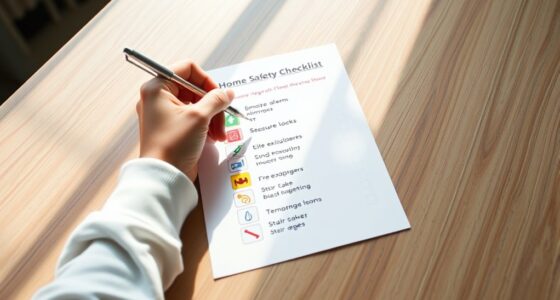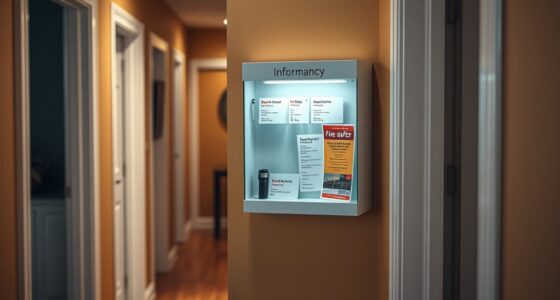To avoid medication mix-ups, focus on clear labeling, organized storage, and proper verification protocols. Use high-contrast labels, separate look-alike medications, and implement barcode scanning at each step of dispensing and administration. Educate staff and patients about medication names and potential confusions, and regularly audit procedures to spot issues early. Building a safety culture and staying vigilant can markedly reduce errors—continue to explore key strategies that keep patient safety your top priority.
Key Takeaways
- Store look-alike and sound-alike medications separately with clear, high-contrast labels to prevent confusion.
- Implement barcode verification during all medication handling steps to ensure correct administration.
- Use tall man lettering and distinct signage to differentiate similar drug names visually.
- Conduct regular staff training and audits to reinforce proper labeling, storage, and verification protocols.
- Educate patients to verify medications and ask questions, fostering an active role in medication safety.
Understanding Common Causes of Medication Mix-Ups
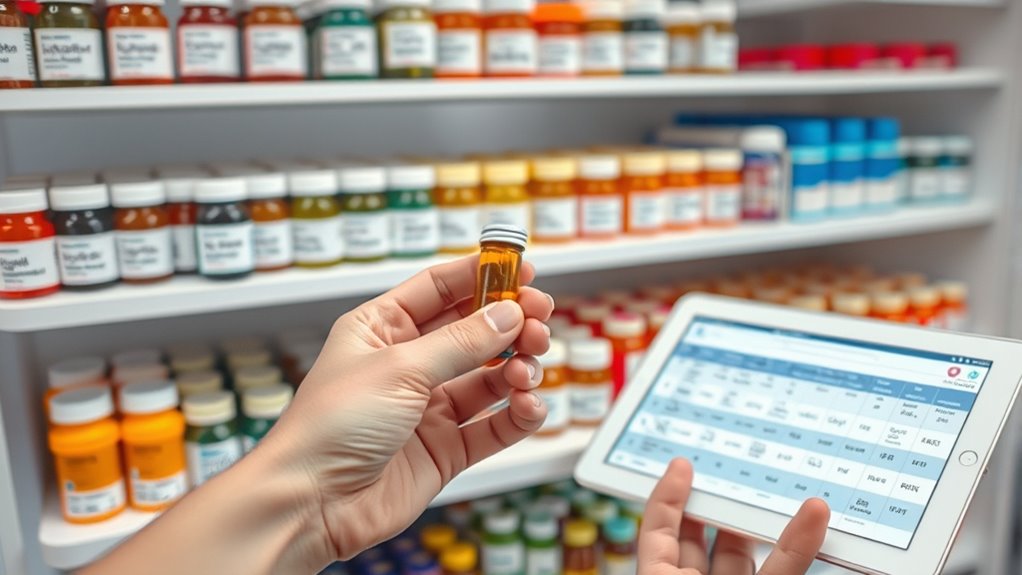
Medication mix-ups often happen because of visual similarities and confusing names. When medications look alike or have similar-sounding names, it’s easy to mistake one for another, putting your safety at risk. This confusion can lead to taking the wrong medication or incorrect dosage, which compromises your health.
To keep your medication safe, healthcare providers and patients need to be vigilant. Always double-check labels, especially when different medications have similar packaging or names. Proper storage is also essential—keeping look-alike medications apart helps prevent accidental mix-ups.
Handwritten prescriptions can add to the confusion, so verifying details is vital. By understanding these common causes, you can better recognize potential hazards and make sure your medication is safe, reducing the risk of errors and keeping you healthy.
Strategies for Proper Medication Labeling and Storage
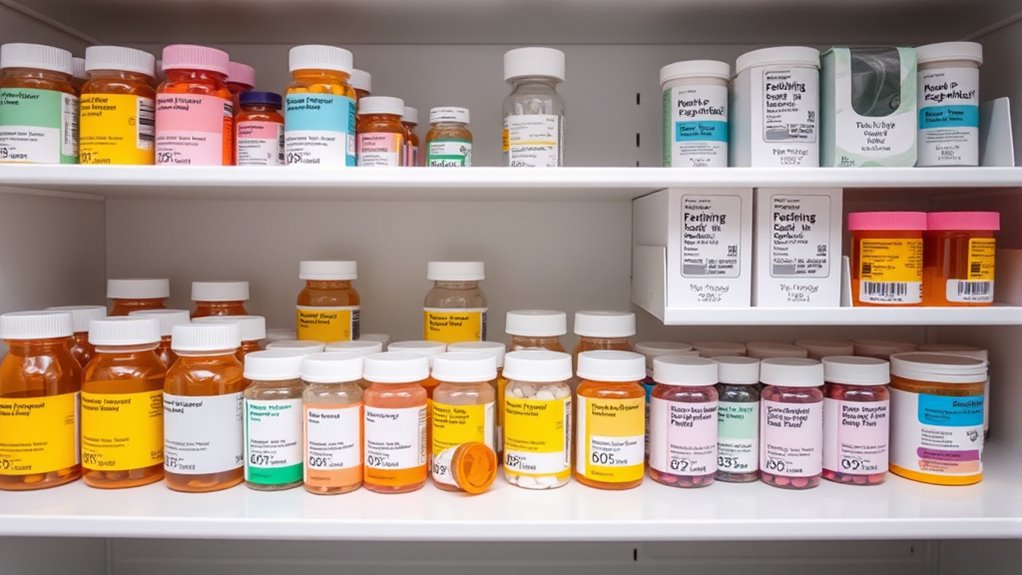
To prevent medication mix-ups, you need to use clear labels and organize your storage areas effectively.
Keep medications with similar names separate and use labeled containers with outward-facing labels for quick identification.
Regularly review and update your storage practices to guarantee safety and reduce confusion.
Clear Labeling Practices
Clear labeling is essential for preventing medication errors and ensuring patient safety. Use large, high-contrast fonts to identify medication names clearly, helping prevent medication mix-ups. Store look-alike or sound-alike meds separately in different locations, such as distinct drawers or bins, to reduce errors. Employ signage, color-coded labels, or shelf talkers to communicate storage changes, especially for high-risk products. Regularly review and update your labeling practices to enhance safety. Proper labeling at the point of prior to administration plays a key role in medication safety. The Institute for Safe Medication Practices (ISMP) recommends diligent labeling to help prevent mistakes. Here’s a quick guide:
| Medication Type | Storage Tip | Labeling Strategy |
|---|---|---|
| Look-alike | Separate locations | High-contrast labels |
| Sound-alike | Distinct areas | Clear font |
| High-risk meds | Segregate | Signage & color codes |
| Regular review | Update labels | Performance improvement |
| Automated Dispensing | Proper labeling | Help prevent errors |
Additionally, understanding medication storage standards can further reduce the risk of errors, especially when combined with clear labeling practices.
Organized Storage Systems
Effective storage systems are fundamental to maintaining medication safety and preventing errors. To achieve this, you should store medications with similar names or appearances separately, using labeled bins, shelves, or drawers. Clearly visible, large labels with full medication names and indications help you quickly differentiate drugs. Implementing customization possibilities in storage solutions can further enhance organization and accessibility. Signage or shelf talkers can be used to mark high-risk or look-alike medications, making them easy to identify. Regularly review and reorganize storage areas to ensure proper spacing and prevent placing similar products next to each other. Proper storage practices are essential for reducing medication errors and ensuring safety in your medication management system. Additionally, utilizing organized storage systems can streamline access and help prevent accidental mix-ups, creating a safer environment for medication use. Incorporating medication safety principles such as proper separation and clear labeling can further improve the effectiveness of your storage setup. Attention to medication storage guidelines can significantly reduce confusion, improve accessibility, and promote safe medication practices in your storage system.
Segregated Medication Areas
Establishing segregated medication areas is essential for preventing mix-ups and ensuring safe storage. You should store medications with similar names or packaging separately, using designated shelves, bins, or locked compartments. Clearly label each area with large signs and use shelf talkers to highlight high-risk or look-alike drugs. Avoid placing confusing medications close together; maintain space to reduce errors. For different strengths or formulations, use separate storage with color-coding or distinct labels. Regularly review and reorganize storage to keep high-risk drugs segregated and labels clear. This proactive approach minimizes chances of selection errors and enhances medication safety. Additionally, implementing proper storage practices can further reduce the risk of medication errors. Proper organization and medication management are vital components of a comprehensive safety strategy. Incorporating error prevention strategies can help identify potential issues before they result in medication mix-ups. As technology advances, integrating electronic labeling systems and automated inventory management can further improve accuracy and reduce human error.
Implementing Technology and Barcode Scanning Safeguards
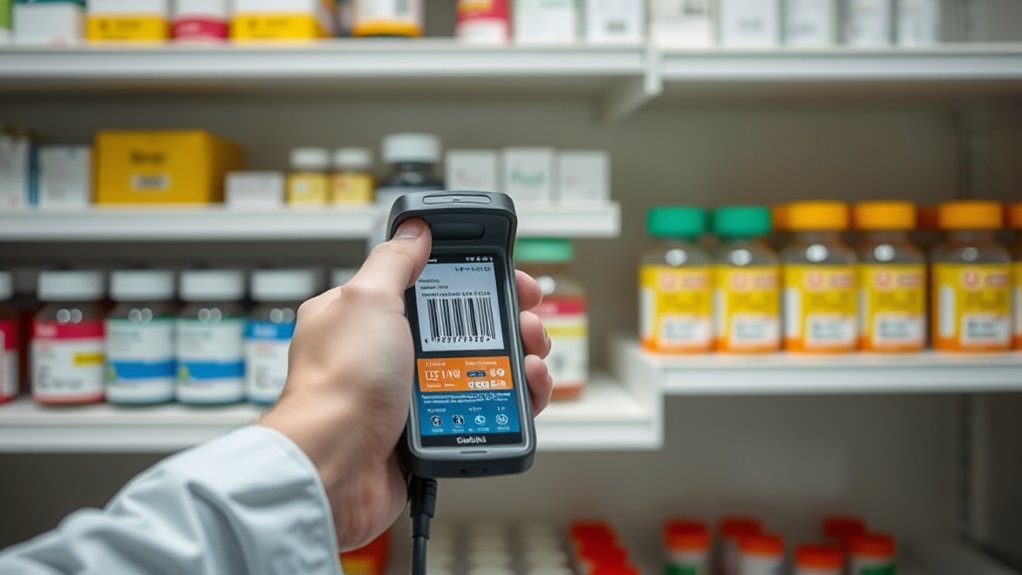
Implementing barcode verification processes is key to reducing medication errors and ensuring patient safety. Using technology such as barcode scanning during each step—selection, delivery, and administration—helps prevent mix-ups. Regular staff training on proper procedures boosts compliance and maximizes the benefits of barcode scanning safeguards. Additionally, understanding medication expiration dates is crucial to avoid administering spoiled medications. Familiarity with regional regulatory requirements can further enhance safety protocols and compliance. Incorporating antioxidant properties awareness into staff training can also support better understanding of medication effects. Moreover, awareness of eye patch benefits can influence comprehensive patient care strategies where appropriate. Emphasizing data-driven strategies in safety protocols can help identify areas for continuous improvement and reduce errors.
Barcode Verification Processes
Have you ever wondered how technology helps prevent medication errors? Barcode verification processes play a *crucial* role in safeguarding patients. When you scan medications during stocking, dispensing, or administration, it confirms the correct drug, dose, and patient match.
Multiple verifications—at selection, before delivery, and at the bedside—add extra layers of safety. Using barcode systems involves scanning both the medication and patient wristbands to cross-verify details. Incorporating real-time data updates can further enhance accuracy and reduce discrepancies. Additionally, integrating medication safety protocols with barcode systems can streamline workflows and reinforce safety standards.
It’s *essential* that staff are trained to handle scanning discrepancies immediately, without bypassing safety checks. Regular audits help *ensure* compliance and identify areas for improvement. Implementing barcode scanning safeguards helps prevent errors caused by manual entry mistakes or system failures. Ensuring system interoperability between devices further minimizes the risk of data mismatches.
These checks reinforce safety protocols and reduce errors, making medication administration more reliable. Proper implementation of barcode verification processes is *vital* to prevent mix-ups and protect patient health. Residency requirements ensure that only eligible individuals participate in the process.
Scanning Protocol Compliance
To guarantee medication safety, healthcare facilities must prioritize strict compliance with barcode scanning protocols. Consistently scanning medications during stocking, dispensing, and administration verifies correct product selection and reduces errors. Implementing bedside barcode scanning ensures medications are matched accurately to patient records before administration, preventing mistakes. Multiple verification steps—scanning at each stage—help catch discrepancies early, especially with look-alike or sound-alike medications. Facilities with high barcode scanning compliance report fewer medication errors related to misidentification. To maintain this, you need to train staff thoroughly on proper procedures and address technical issues promptly. Regular audits and feedback encourage adherence, creating a culture of safety. When everyone follows the scanning protocol diligently, you markedly enhance medication safety and reduce the risk of dangerous mix-ups. Utilizing technological safeguards such as barcode scanning reduces human error and boosts overall medication safety. Emphasizing protocol adherence ensures that safety procedures are consistently followed, further minimizing the risk of medication errors. Additionally, integrating compliance with guidelines from authoritative sources helps sustain high standards and continuous improvement in medication safety practices. Moreover, understanding the importance of security zone info related to medication storage can further prevent unauthorized access and enhance safety measures.
Best Practices for Prescribing and Verifying Medications
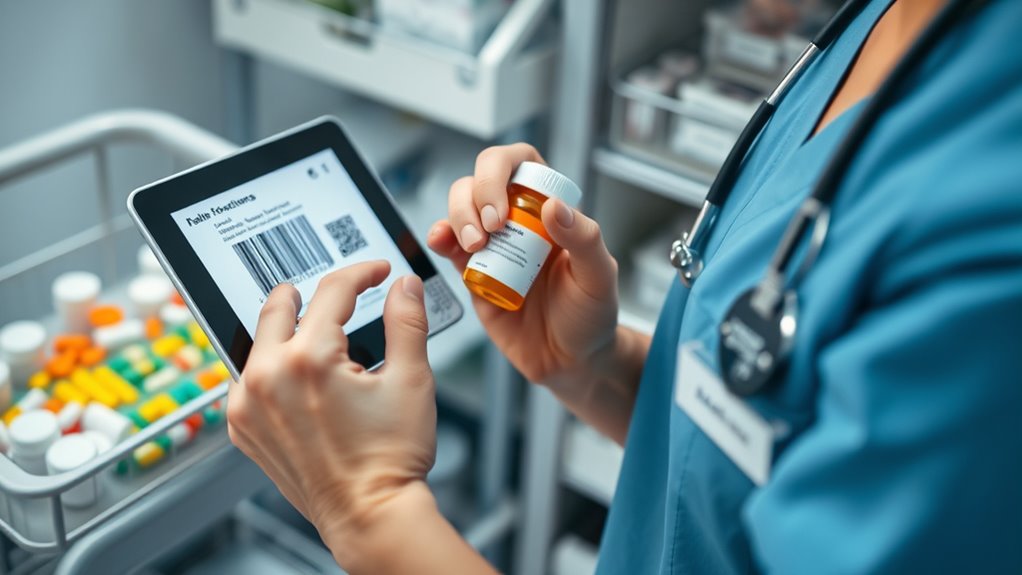
Ensuring medication safety starts with precise prescribing and thorough verification processes. To minimize errors, always write out both the full generic and brand names of medications, avoiding abbreviations that can cause confusion. Use tall man lettering on electronic screens, labels, and order sets—following FDA and ISMP guidelines—to distinguish look-alike drug names clearly.
Verify every detail—medication, dose, route, and indication—against the patient’s condition before dispensing or administering. Cross-check labels multiple times during medication selection, delivery, and just prior to administration, utilizing barcode scanning if available.
Additionally, educate healthcare staff on the risks of look-alike and sound-alike medication names, emphasizing the importance of diligent verification procedures to prevent mix-ups and guarantee patient safety.
Educating Healthcare Staff and Patients on Medication Safety
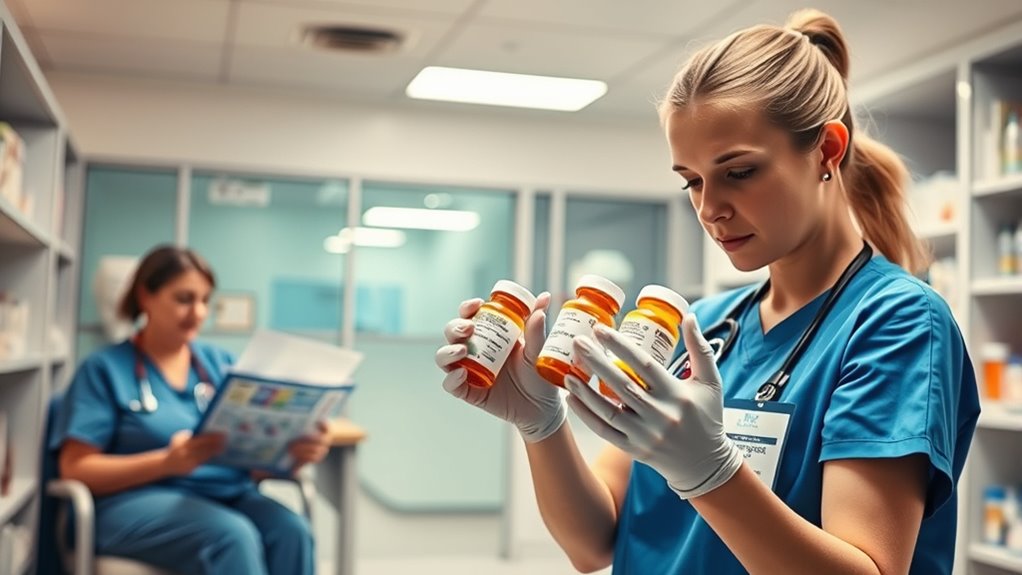
Educating healthcare staff and patients on medication safety is essential for reducing errors and improving patient outcomes. Regular training for staff on look-alike and sound-alike medications, along with tall man lettering, can notably lower mistakes.
Providing patients with clear verbal and written instructions helps prevent misunderstandings and accidental mix-ups. Encourage patients to question unfamiliar medications and verify labels before use, acting as a crucial safety check.
Training staff on barcode scanning and verification procedures enhances accuracy. Using resources like flyers, educational videos, and safety checklists supports ongoing education efforts for both staff and patients.
When everyone understands medication safety principles, the likelihood of errors diminishes, ensuring safer medication practices and better health outcomes.
Maintaining Accurate Medication Lists and Records
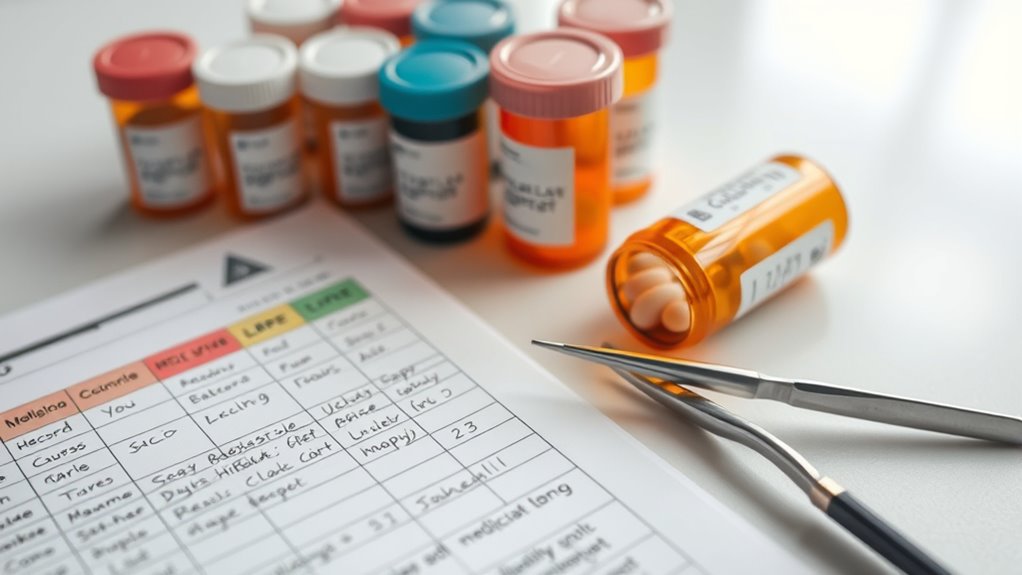
Keeping an accurate and up-to-date medication list is essential for your safety and effective communication with healthcare providers. It helps guarantee you receive the right treatments and provides a quick reference during emergencies.
To stay organized, consider:
- Creating a detailed list with medication names, dosages, and schedules
- Keeping copies at home, in your bag, and accessible during visits
- Recording prescribed doses and specific instructions
- Using clear labels and separate storage to prevent mix-ups
- Reviewing and verifying your list with healthcare providers before new prescriptions
Regularly updating your medication list ensures all information remains current and accurate. This practice minimizes errors, supports adherence, and enhances your overall safety during medical care.
Creating a Culture of Safety and Continuous Improvement
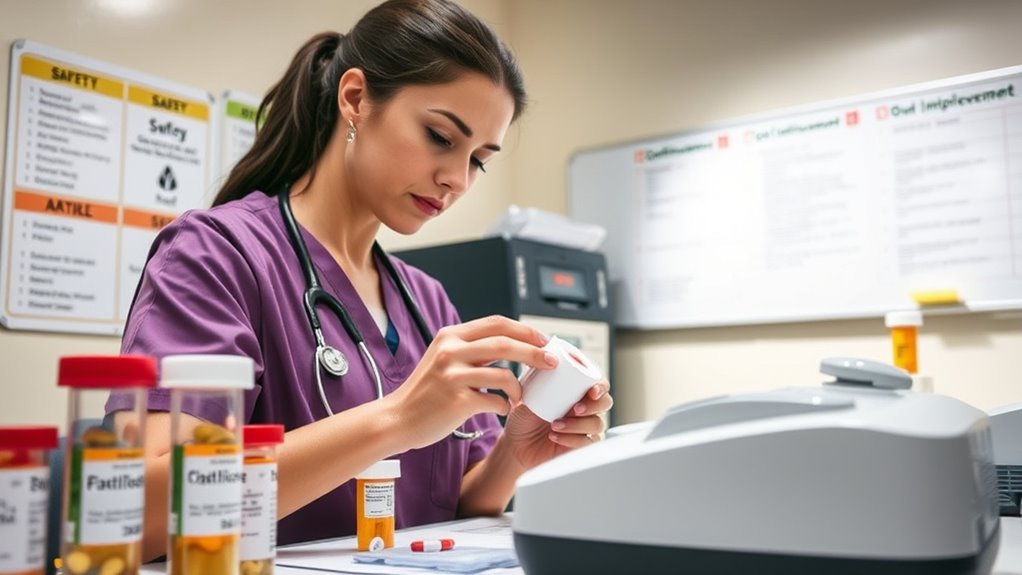
How can healthcare organizations foster a culture where safety becomes a shared priority? It starts with strong leadership commitment that emphasizes the importance of medication safety.
Open communication encourages staff to report errors and hazards without fear of blame, creating a non-punitive environment.
Open communication fosters a blame-free environment where staff feel safe to report errors and hazards.
Regular staff training and ongoing education reinforce best practices, keeping safety at the forefront daily.
Implementing systematic checks like barcode scanning and tall man lettering further reduces the risk of mix-ups.
Continuous monitoring of safety metrics and incident reports helps identify trends and guides targeted improvements.
Promoting teamwork and a just culture motivates everyone to participate actively in safety initiatives.
When safety becomes a shared value, it’s easier to build a resilient system that minimizes medication errors and fosters ongoing improvement.
Recognizing and Responding to Medication Errors
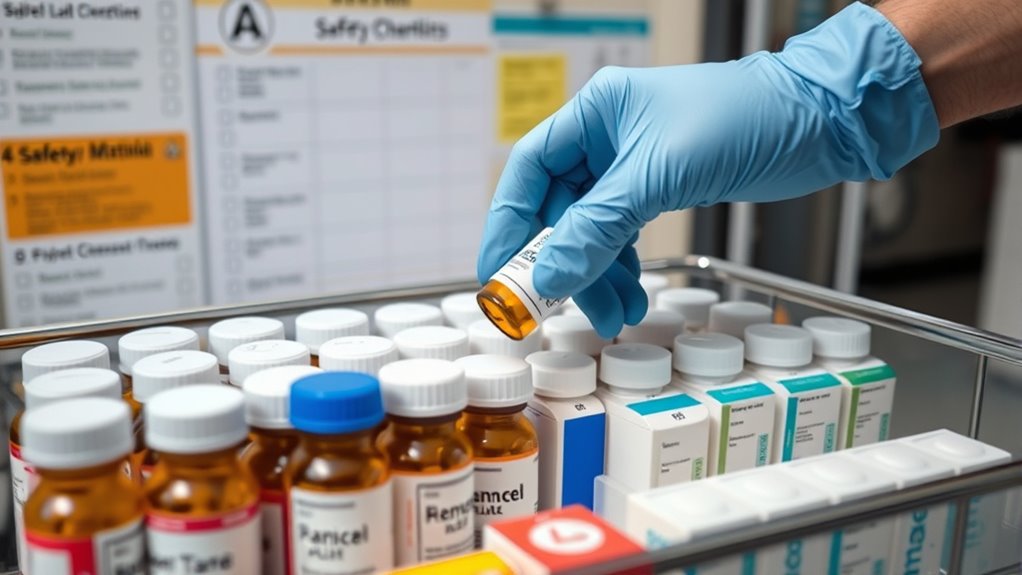
Recognizing medication errors promptly is essential to preventing patient harm and ensuring safe care. You need to stay alert for signs like adverse reactions, missing expected effects, or unusual symptoms.
When you suspect a mistake, report it immediately through your facility’s safety protocols to enable quick investigation and correction.
Verifying medication details with patients and caregivers helps confirm accuracy and catch errors early.
Using technology such as barcode scanning and clear labeling plays a crucial role in reducing mistakes and aids in swift recognition.
To stay vigilant, remember to:
- Watch for adverse reactions or unexpected symptoms
- Confirm medication details with patients or caregivers
- Use barcode scanning and proper labeling
- Report suspected errors without delay
- Document all findings accurately
Quick recognition and response are key to safe medication management.
Frequently Asked Questions
What Medicines Should Not Be Mixed Together?
When considering which medicines shouldn’t be mixed, you need to be cautious. You should avoid combining antibiotics like penicillin with corticosteroids, as they can react negatively.
Don’t mix calcium and phosphate solutions to prevent precipitates.
And steer clear of potassium chloride with sodium bicarbonate to avoid clogging veins.
Always check compatibility charts or ask your pharmacist before mixing drugs to keep your patients safe.
What Are the 5 R’s of Medication Administration?
You’re asking about the 5 R’s of medication administration. To guarantee safety, you verify the right patient by checking two identifiers, confirm the right drug by comparing labels to the prescription, and guarantee the right dose by calculating accurately.
You also administer via the right route and at the right time. Following these steps helps prevent errors and promotes effective, safe medication use.
What Are the 7 Steps of Medication Safety?
The 7 steps of medication safety guide you through every stage of medication management. You start by prescribing the right medication, then transcribe accurately, dispense correctly, and administer carefully.
You monitor the patient’s response, document each step thoroughly, and review the entire process regularly.
What Is One Way to Help Avoid Interactions Between Multiple Medications the Individual Is Taking?
To help avoid interactions between multiple medications you’re taking, you should create a thorough, up-to-date medication list. This way, you can easily share it with your healthcare providers and pharmacists.
Using a single pharmacy for all prescriptions is also effective, as it allows them to review your medications for potential interactions.
Regularly consulting your healthcare provider ensures any concerns about drug interactions are addressed promptly.
Conclusion
By staying vigilant and following best practices, you can greatly reduce medication mix-ups. Implementing proper labeling, leveraging technology, and educating both staff and patients are key steps. Did you know that medication errors harm at least 1.5 million people annually in the U.S.? By creating a culture of safety and continuous improvement, you help protect lives and ensure medication safety remains a top priority in your healthcare setting.



